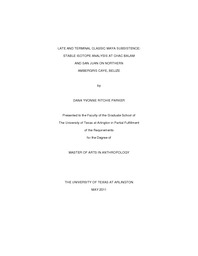
ATTENTION: The works hosted here are being migrated to a new repository that will consolidate resources, improve discoverability, and better show UTA's research impact on the global community. We will update authors as the migration progresses. Please see MavMatrix for more information.
Show simple item record
| dc.contributor.author | Parker, Dana Yvonne Ritchie | en_US |
| dc.date.accessioned | 2011-07-14T20:54:15Z | |
| dc.date.available | 2011-07-14T20:54:15Z | |
| dc.date.issued | 2011-07-14 | |
| dc.date.submitted | January 2011 | en_US |
| dc.identifier.other | DISS-11187 | en_US |
| dc.identifier.uri | http://hdl.handle.net/10106/5855 | |
| dc.description.abstract | Skeletal populations from several Maya sites during the Late and Terminal Classic periods exhibit pathologies indicative of poor health and malnutrition, while populations from other sites appear comparatively healthy. Chac Balam and San Juan from Ambergris Caye in Belize are examples of flourishing sites with skeletal populations that possess few indicators of nutritional stress. Analysis of stable carbon and nitrogen isotopes on bone collagen and carbon isotopes on bone apatite from 30 individuals was conducted to elucidate dietary intake of the populations from Chac Balam and San Juan. Results indicate dietary possibilities typical for an island population, with primary food sources coming from the sea supplemented with terrestrial plants and fauna. No significant differences were found between males and females or adults and juveniles from these sites. Differences found between social groups indicate lower status individuals relied more on local resources and higher status individuals/elites perhaps had differential access to imported meat or produce. | en_US |
| dc.description.sponsorship | Smith, Shelley | en_US |
| dc.language.iso | en | en_US |
| dc.publisher | Anthropology | en_US |
| dc.title | Late And Terminal Classic Maya Subsistence: Stable Isotope Analysis At Chac Balam And San Juan On Northern Ambergris Caye, Belize | en_US |
| dc.type | M.A. | en_US |
| dc.contributor.committeeChair | Smith, Shelley | en_US |
| dc.degree.department | Anthropology | en_US |
| dc.degree.discipline | Anthropology | en_US |
| dc.degree.grantor | University of Texas at Arlington | en_US |
| dc.degree.level | masters | en_US |
| dc.degree.name | M.A. | en_US |
Files in this item
- Name:
- Parker_uta_2502M_11187.pdf
- Size:
- 1.074Mb
- Format:
- PDF
This item appears in the following Collection(s)
Show simple item record


